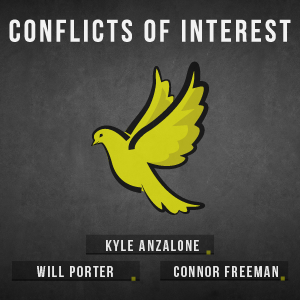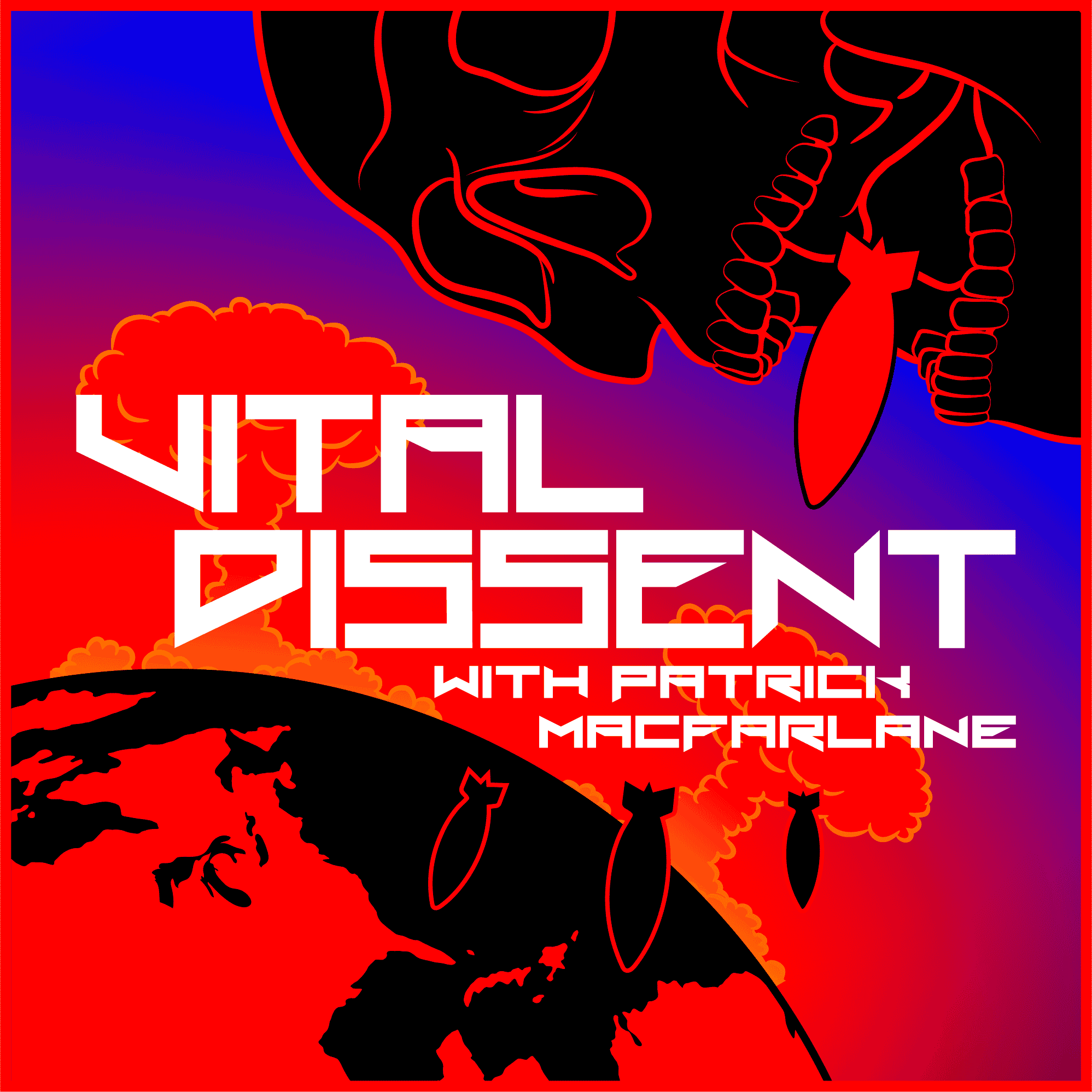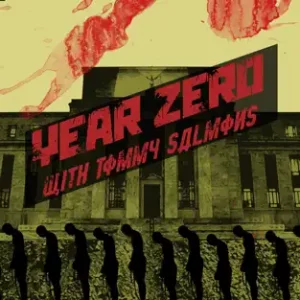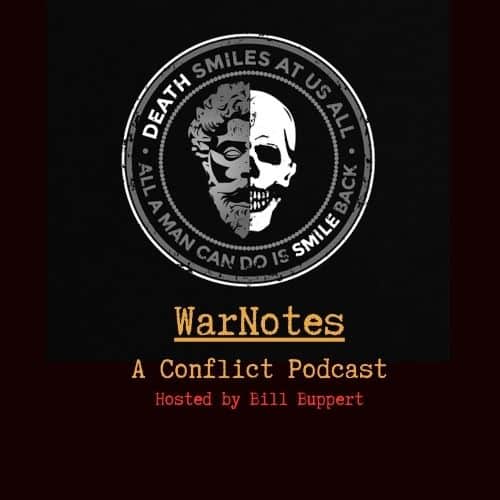Michael Liebowitz invited me back to talk about whether we should have a government.
Blog

Happy 30th Birthday Antiwar.com !!!
It has been thirty years since the website Antiwar.com was launched. A defiant reaction to the Clinton administrations interventions in the Balkans during the 1990s. Founded by the late Justin Raimondo and Eric Garris, the site went on to become a platform of information and reporting against US military interventions, and eventually as opposition to all wars. Though, often criticised for being “right wing”, the founders from the modern American tradition of libertarianism. Antiwar.com is principally anti-war, and has contributors and writers from all spectrum’s of politics. The main mission being, peace.
In the thirty years since Antiwar.com was founded, there has not been a decrease in war or US military interventions. Unfortunately, there has been an increase. The website and its dedicated writers and the journalists they cite, not to mention the behind the scenes crew and those involved in the multimedia front remain vigilant and dedicated to the cause for peace.
There is a bitter sweet dignity in opposing war, while on the surface it may seem as a universal belief held by most people. It’s less common than many would realise. There is always a war, or an intervention that proves an exception for many people. Always, a coercive action, an innocent life that should be killed, the victims of policy a reasonable calculation made by those far in the distance, all by those who consider themselves as good and moral people. If not pragmatic. Antiwar.com provides a challenge to power, all power and retains a consistency. If does not bow to preferred nations, or ideologies and instead champions the innocent.
The Libertarian Institute is a sibling of sorts to Antiwar.com. They share some of the same people and are each focused on human liberty, ending the wars. The concept and ideal of Antiwar.com is one that has stood for three decades, seen countless contributors, each with passion and dedication expressing a plea for peace. Reporting on the wars and conflicts with speed and honesty, even in the heated moments of uncertainty.
To those who have dedicated themselves to the Antiwar.com project do so, not for fame or wealth. There are far easier things people of such talent and dedication could focus their energies on. Instead they do so with modesty and humble silence. The nature of war, indifference from the wider population and cynicism of those in power is a toll that wanes on them. To look at the images, the footage of death, human misery, to read the reports, and articles on the policies of indifference to those from the ground where the stench of death and tears of the bereaved are real, wears on the human spirit and haunts the mind. Those dedicated to Antiwar.com don’t see the dead as statistics or the innocent as a ‘them’. They seen them as human beings, no different from themselves.
On the podcast and multi-media front, Antiwar.com with Dave DeCamp , Kyle Anzalone and Connor Freeman have kept up with consistent reporting on the wars and what is occurring for those who may have no time to read the articles or explore the news feed. They do so, following in the footsteps of Scott Horton who over the decades, with thousands of interviews has put anti war and antiwar.com at the forefront of his show with the spirit of the website in the pages of his books.
The writers over the years have been hard to count, Doug Bandow, Ted Carpenter, Ramzy Baroud, Pat Buchanan, David Stockman, Daniel Larison, Ted Snider, Danny Sjursen, Ray McGovern, Sheldon Richman, David R. Henderson, and Matthew Barganier. To, Jason Ditz, Praful Bidwai, Alan Bock, Bevin Chu, Mike Ewens, Emmanuel Goldstein, Ran HaCohen, Stella Jatras, Nebojsa Malic, Sascha Matuszak, Christopher Montgomery, Joseph Stromberg, Gene Berkman, Tom Engelhardt, Sam Koritz, Neil Maccalder, John McCarthy, Tracey Milton, Pete Papageorge, Mark A. Petricevic, Rick Rozoff, and Elizabeth Wisniewska. Ramzy Baroud and Danny Sjursen. I know I likely have forgotten some, or neglected to include others. With Angela Keaton as a now behind the scenes executive director, who was once publicly campaigning for peace. With many more who work tirelessly behind the scenes.
It’s not that Antiwar.com is solely fixated on opposing the wars. It’s a landing page of original pieces and articles, with an extensive archive that goes back into the past. It’s an ideal which stands for human freedom, individual liberty, human rights in the purest sense of the word. The freedom to not be coerced, to not be killed and enslaved. It’s anarchist or libertarian in that sense, after all what exemplifies government and collectivism more than war itself. The belief that brutal and naked force can be used on a population to achieve an imperial or political goal, is terror, criminal, repugnant but above all government incarnate. The use of mass violence, to starve and murder thousands, even millions is perfectly legal when inflicted by a government, especially one with power. Small bands of killers, cartels and rogues, led by a warlord, when they murder and torture we understand it to be criminal. Antiwar.com does not disseminate. They speak for the innocent, regardless of who is doing the killing.
In the beginning, in those moments of lead up and during the onslaughts of death, many in the media and among the public and governmental class are certain of the righteousness for each war. They may have reservations in private, whispered concerns, outwardly they are on point with the message of war. Over time, whether because of defeat, attrition, the cost was too high or thanks to whistle blowers the many certain supporters switch and become critics. They can afford to change their minds, it may even be politically expedient to do so. They lost nothing. Antiwar.com is there from the beginning, before it’s popular to oppose the war. Even the wars many, in this moment, think should happen, Antiwar.com stands for peace.
This set of principles and code of honour, has also made the site unpopular at tines. Domestic political partisanship often sees the antiwar sentiments shift from election, not to mention the bigoted bias found inside nationalism or religion, whereby injustice can be ignored, overlooked or even justified so long as it’s the familiar or friendly doing such evil acts. Antiwar.com is secular in this regard. Internationalist, humanist, free minded and independent. To achieve this over thirty years takes both tenacity and willpower, which is only possible when good people stay the course. It is not filled with pacifist hippies, rather human beings who don’t support collective punishment and mass murder.
Behind the scenes and in their intimate moments, those involved at Antiwar.com are all human beings, they tire and waver. Though, regardless they persevere. It takes courage to defy power, to speak truth despite propaganda’s appeal or the emotional irrationality of the mob. Their is a determination of spirit expressed over the years, a human union that defies ideologies, religion or culture, the belief in peace. The fundamental and basic understanding that human beings don’t deserve to be murdered.
On a personal note, whenever I grow weary or stumble, I find strength in the work and consistency of those at Antiwar.com. I recall the first time I came across the site in the late 1990s, it had been shared on a fight forum. Someone posted an article, it sparked conversation. I returned often to the site. It’s format and up to date links and articles was a super power for knowledge. I may have been helpless but I was informed and found an energy in the existence of the page, the dedication of those behind it. In the 2003, protests against the Iraq war, I saw a lady who had written in texta on her shirt, “Antiwar.com.” I felt pride in seeing her in that makeshift shirt. I know feel pride in knowing those who work so hard behind the scenes. They are my heroes. I hope in time, more people find the site, are informed and become antiwar. The innocent, the planet deserves peace. If more people visited and read Antiwar.com, it’s safe to say it would be a better world.
“Truth is treason in the empire of lies,” Ron Paul.
Happy 30th birthday and thank you all for what you do. Merry Christmas and a Happy New Yea of Peace to everyone.
Did TSA Finally Grab the Wrong Groin?
Evita Duffy-Alfonso, the pregnant daughter of Secretary of Transportation Sean Duffy, tore into TSA last week over the abuse she suffered prior to a recent flight. Writing on X on Thursday, she called for abolishing TSA:
I nearly missed my flight this morning after the TSA made me wait 15 minutes for a pat-down because I’m pregnant and didn’t feel like getting radiation exposure from their body scanner. The agents were passive-aggressive, rude, and tried to pressure me and another pregnant woman…
— Evita Duffy-Alfonso (@evitaduffy_1) December 18, 2025
Some people responded to her broadside by urging her to tell her complaint to her father. But as she repeatedly patiently explained, TSA is part of the Department of Homeland Security, not the Transportation Department. No wonder TSA seems to oppose transportation – or at letting people take a flight without running a boneheaded bureaucratic gauntlet.
Many women responded to Duffy-Alfonso’s tweet with their own experience of TSA abuse:
As a bilateral cochlear implant recipient, I have to opt for a pat-down screening. Even after informing TSA officers about my devices before screening and my limitations to understanding speech in noisy environment— they have been rude, impatient, and have deliberately swiped…
— Ellen Streiff (@EllenStreiff) December 18, 2025
Agree, I have had multiple bad experiences including bleeding from rough handling.
— Dragonflynda (@Dragonflynda) December 18, 2025
They never swabbed my palms until I was carrying a baby 😑
— Sour Patch Lyds ن (@sourpatchlyds) December 18, 2025
Oh Momma,
Thousands (maybe 100s or millions) of Momma’s feel this!Wait ’til your child is 8 and “tests positive” for “residual explosive sediment” on her hands (allegedly).
Pro-tip: kids can’t be frisked. Their mother is.TSA is an invasive joke.
— TheSaltyMom (@SaltyMommaC) December 18, 2025
Yes, I’m in a wheelchair and have to do this every….damn….TIME!!
— Katie Brooker (@lotusrosekat) December 21, 2025
Many commenters slammed Duffy-Alfonso for failing to arrive at the airport a full two hours before her flight. Since when did an inept federal agency become entitled to blight much of the day for innocent travelers? Other commenters sneered that she should have taken the bus.
@AuntieFah420 responded: “Entitled little bitch. STFU”
And:
Cry harder you spoiled twat
— Randy‼️ (@RandyHeyyyy) December 21, 2025
Many of the people who scoffed at her complaint sounded like Trump supporters. Some commenters blamed Muslims for all of TSA’s abuses – since if not for the “Religion of Peace,” there would presumably never be any threat to air travel safety.
The backlash produced by the Duffy-Alfonson reminded me of the outrage proved by a 2017 piece I wrote for USA Today piece headlined, “Thanksgiving travel: Trump’s holiday gift is more invasive airport security.” TSA became abusive and intrusive after Trump first became president. My article discussed the case of Jenna McFarlane, a 56-year old teacher. A TSA agent told her “to spread my legs wider” and proceeded to “touch my vagina four times with the side of her hand,” as she formally complained to TSA afterwards. One Twitter user sneered: “Jenna McFarlane is just upset that it was only four times.”
I had been bashing TSA ever since it was created in 2002 by President George W. Bush. But “due diligence” was no impediment to readers enraged by any criticism of Trump policies. I was tagged as a pussy snowflake, libtard, moron, brain dead, clown, left wing bigot, dopey liberal, leftist loon, “leader of the idiots,” and stinkin’ libertarian.
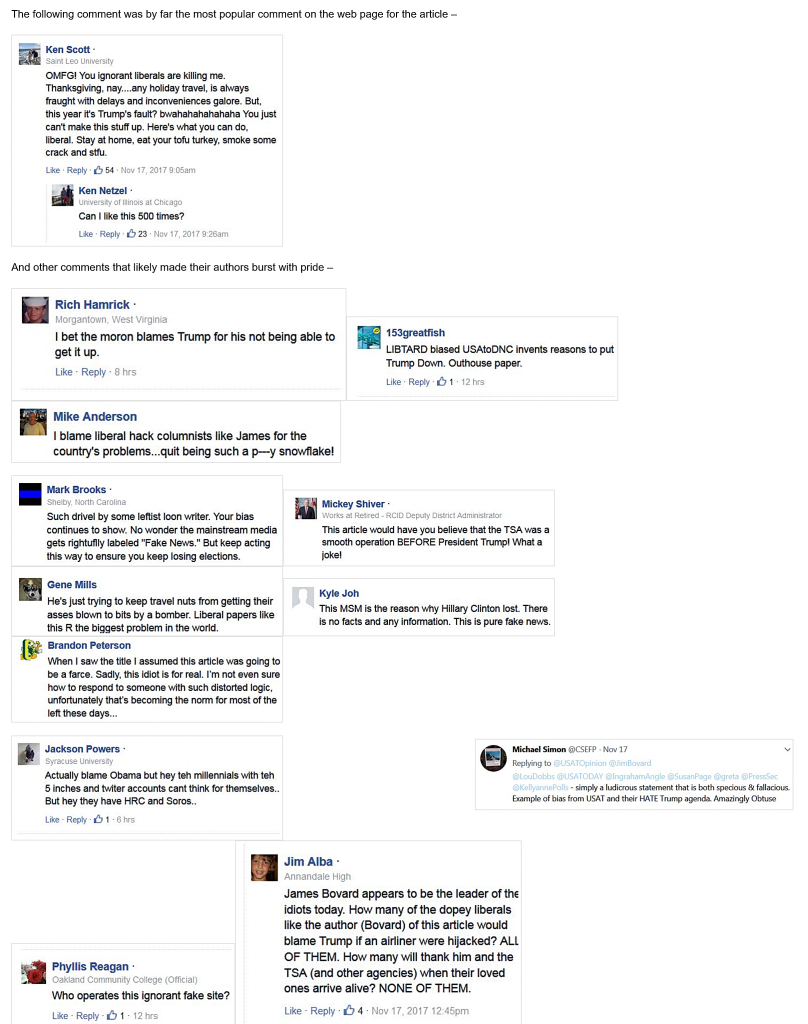
I was surprised to see so many people’s devotion to the president lead them to absolve an agency that has long abused Americans.
In her tweet slapdown, Duffy-Alfonso declared, “Perhaps things would have gone more smoothly if I’d handed over my biometric data to a random private company (CLEAR). Then I could enjoy the special privilege of waiting in a shorter line to be treated like a terrorist in my own country.” That resonated with my TSA experiences in the last couple years. When I was flying out of Dallas International Airport in 2023,

I saw two women loitering behind a roped off section for CLEAR, a new biometric surveillance program that works with 35 airports and coordinates with TSA. CLEAR involves travelers standing in photo kiosks that compare their faces with a federal database of photos from passport applications, driver’s licenses, and other sources. The Washington Post warned that airport facial recognition systems are “America’s biggest step yet to normalize treating our faces as data that can be stored, tracked and, inevitably, stolen.”
Though the CLEAR program is purportedly voluntary, TSA agents at Washington National Airport recently threatened long delays for any passenger who refused to be photographed by CLEAR, including U.S. Sen. Jeff Merkley (D-OR). Merkley said that TSA falsely claimed there were signs notifying people that the facial scans are optional. But the clock is ticking down on seeking voluntary cooperation. TSA chief David Pekoske announced in early 2023 that “eventually… we will require biometrics across the board.”
I raised my phone camera, snapped a few shots of the women, and the howling commenced.
“What are you doing?” screamed a young woman wearing a CLEAR jacket. “You can’t take my photo!”
“But you’re scanning people’s eyeballs,” I replied. What could be more intrusive?
“That doesn’t matter because you can’t take our photo – it’s not allowed!” She sounded as if I had desecrated a federal temple.
With her three-inch artificial fingernails, I wondered if she planned to audition for a Dracula movie. Her colleague speedily exited, perhaps to summon police to end my assault. But if airport officials had sought to seize those photos, they would have faced a legal ruckus.
When I was flying out of Palm Beach Airport in Florida in October, the TSA checkpoint was structured so that the default was for every traveler to get their photo taken for CLEAR. A middle-aged TSA agent got perturbed when I wouldn’t stand in the right spot by his desk for the photo. I said I didn’t want my photo taken. “You don’t want your picture taken?!” he responded testily. “Then I need to see your identification.”
I handed him my driver’s license and he held it up a couple different times as he looked past it to see if I falsely claiming to be someone TSA agents ritually hated. He took my boarding pass and looked at it intently – almost like he hadn’t done so well on his “Hooked on Phonics” refresher course.
He finally deigned that I could proceed to the frickin’ Whole Body Scanner but I was supposed to have a sense of shame for failing to trust Leviathan.
Duffy-Alfonso’s condemnation of TSA is refreshing regardless of whether it spurs the Trump administration to repent. But the outrage that her comment evoked on Twitter does raise the question: How many Trump voters abandoned their opposition to unleashing federal agencies after Trump was back in the Oval Office? Since Trump is in the Oval Office, are private citizens presumptively the villains whenever they clash with federal agencies?
TSA abuses will generate a new torrent of online complaints between now and New Year’s Day. Perhaps we will learn whether the Trump White House gives a damn about to any abuse of government power that doesn’t specifically target Trump supporters or donors. Unfortunately, Trump and all his billionaire buddies fly on official or private jets that are exempt from TSA abuses.
Trump Debuts the Next US Navy Ship Disaster

POTUS revealed the latest US naval ship catastrophe, the Mango Emperor-class battleship.
Apparently he and his staff did not get the memorandum from 8 December 1941.
The US Navy has not built a successful hull since the Arleigh Burke (early 90s) and has had huge problems with the Zumwalt, Little Crappy Ship and the Ford carrier.
Did I mention the latest mercifully euthanized USN Constellation frigate program that got cancelled after the Navy sunk nearly $2 billion into the program before cutting it in late 2025, with costs per ship rising from $1B to $1.4B? Those costs would not have been near accurate if recent history is any indication.
No one responsible for those massive shipbuilding fiascos has been disciplined, fired or cashiered.
No one has been held responsible.
Make the USN Board of Inspection and Survey (INSURV) and the Navy Inspector General great again with merciless transparency and revelation.
No one has informed the US naval intelligentsia and the cool kids in uniform and that the missile age at sea, salvo competition and a war of leakers put all 21st century surface warfare in the hazard without a radical reappraisal of how peer combat at sea in a contested environment will work out for exquisite platforms.
My forecast: if they proceed with this folly, they will adopt concurrent technology (not mature at hull construction), they will proceed with construction with a percentage of the design unresolved, it will be over-budget & very late in schedule delivery, the USN will accept incomplete hulls and once commissioned it will be rife with operational readiness delays and major flaws in construction.
Same as it ever was.
Shame.
PS: American shipyards are building three of the 5,448 large commercial vessels on order worldwide.
https://www.navy.mil/Press-Office/Press-Releases/display-pressreleases/Article/4366856/president-trump-announces-new-battleship/
The Bloody Weekend: Netanyahu’s Blame Game, Americans Killed, and the Fuentes Backlash
The weekend should have been quiet. Instead, a Hanukkah celebration on a Sydney beach turned into a massacre, a Muslim bystander tackled a shooter, and within hours the tragedy was weaponized. We dig into what happened, why the early “false flag” whispers took hold, and how Benjamin Netanyahu used the moment to argue that supporting a Palestinian state is the same as fueling antisemitism. That framing doesn’t just poison debate—it endangers Jewish communities by collapsing criticism of state policy into bigotry against a people.
We also trace another deadly thread: three Americans killed near Palmyra, Syria, and the fog that followed. First it was ISIS. Then reports pointed to a member of Syria’s own security forces with a jihadist past. If the original mission in Syria was to destroy the Islamic State, why are U.S. troops still in harm’s way years later? We lay out the mission creep, the shifting justifications, and the growing talk of adding troops to “monitor” ceasefires that rarely hold. If the rationale has evaporated, the policy should too.
On the media front, we examine Barry Weiss’s interview framing around the Charlie Kirk case and why public trust erodes when legitimate questions are lumped with the most absurd conspiracies. Candace Owens scored early with receipts, then drifted into claims she hasn’t substantiated. That pattern fuels both cynicism and polarization. And on Capitol Hill, Chuck Schumer’s resolution condemning “platforming” Nick Fuentes tries to police conversations rather than win arguments. We break down why Tucker Carlson’s approach—separating people from governments, rejecting blood guilt, and aiming to persuade the audience—may be the smarter way to defuse extremist appeal.
If you care about free speech, accurate reporting, and a foreign policy that reduces risk instead of multiplying it, this conversation is for you. Subscribe, share with a friend who follows world news, and leave a review telling us where you think U.S. policy and media narratives go wrong.
Podcast (kyle): Play in new window | Download
Christmas Hiatus

Latest Interview
I sat down recently with LiquidZulu to talk about anarcho-capitalism, Objectivism, and other things.
Truth in Advertising in the UK At Last

I love it that the National Health Service (NHS) socialist medical horror show in the UK uses the handle NHSuk on the X.
The United Kingdom prides itself on this crown jewel of medical malpractice & incompetence that is a love child of Benny Hill, Trofim Lysenko and Nikolai Alexandrovich Semashko.
Yes, it does indeed SUCK.



